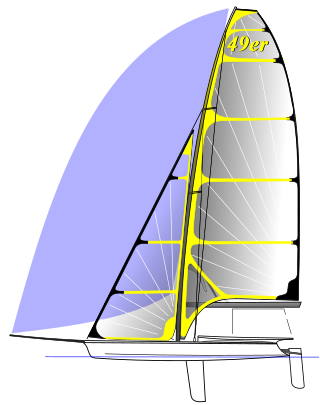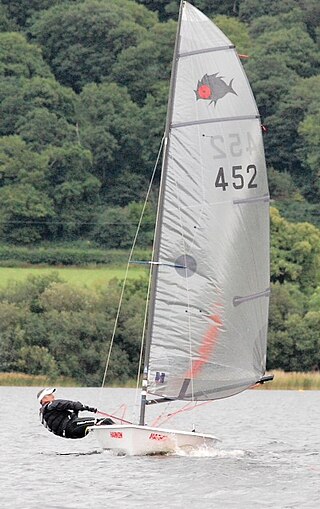
Dinghy sailing is the activity of sailing small boats by using five essential controls:

Boat building is the design and construction of boats and their systems. This includes at a minimum a hull, with propulsion, mechanical, navigation, safety and other systems as a craft requires.

The National 12 is a two-person, two-sail, twelve-foot long sailing dinghy. They are sailed extensively in the UK. The class was started in 1936 by the Royal Yachting Association as an alternative to the more expensive International 14s.

The Wayfarer is a wooden or fibreglass hulled fractional Bermuda rigged sailing dinghy of great versatility; used for short 'day boat' trips, longer cruises and for racing. Over 11,000 have been produced as of 2016.

The 470 (Four-Seventy) is a double-handed monohull planing dinghy with a centreboard, Bermuda rig, and centre sheeting. Equipped with a spinnaker, trapeze and a large sail-area-to-weight ratio, it is designed to plane easily, and good teamwork is necessary to sail it well. The name comes from the boat's length of 470 centimetres.

The 49er and 49er FX is a two-handed skiff-type high-performance sailing dinghy. The two crew work on different roles with the helm making many tactical decisions, as well as steering, and the crew doing most of the sail control. Both of the crew are equipped with their own trapeze and sailing is done while cantilevered over the water to the fullest extent to balance against the sails.

Hobie Cat is a company that manufactures sailing catamarans, surfboards, sailboats, kayaks, stand-up paddle boards, and pedalboards as the Hobie Cat Company. It was founded in 1961 by Hobart Alter, who originally manufactured surfboards. Its line of products has included more than twenty sailing craft, plus a variety of other watercraft.

The Fireball is a British sailing dinghy that was designed by Peter Milne as a one-design racer and first built in 1962.

The Tasar is a 14.83-foot (4.52 m) fiberglass 2 person sailing dinghy with a mainsail and jib. Designed by Frank Bethwaite of Sydney in 1975, the boat was technologically advanced for its time and continues to evolve. Aimed at a husband-and-wife or parent-and-child crew hence no spinnaker, it is designed for a combined crew weight of around 140 kg. The hull weighs 68 kg, and is of sandwich foam construction. The hull has a fine angle at the bow to reduce wave impact drag with unusually clean and sharp chines aft to ensure very free planing and outstanding stability. The foam cored hull is stiff and light and the advanced hull shape, together with an innovative rig which combines a rotating mast with a fully battened main sail, allows the Tasar to plane upwind with the crew normally hiked. The wide beam and a cockpit designed for comfortable hiking make the Tasar easy, fun and very exciting to sail in winds up to 25 knots (46 km/h).

The 18 ft Skiff is considered the fastest class of sailing skiffs. The class has a long history beginning with races on Sydney Harbour, Australia in 1892 and later in New Zealand. The boat has changed significantly since the early days, bringing in new technology as it became available. Because of the need of strength, agility and skill, the class is considered to be the top level of small boat sailing. Worldwide this boat is called the "18 Foot Skiff". It is the fastest conventional non-foiling monohull on the yardstick rating, with a score of 675, coming only third after the Tornado and Inter 20.

The International 14 is a British racing sailboat, crewed by two sailors. The class was established in 1928.

The Laser Stratos is an all-round cruising and racing boat designed by Phil Morrison and built by LaserPerformance, the same company as the famous Laser Standard dinghy. It is built from fibre-glass and foam sandwich. The Laser Stratos comes in two forms, one with a keel and one with a centreboard. The centreboard version is red and the keel version is blue. The Stratos is quite spacious and most of the rigging is kept out of the way. The boat can optionally be fitted with trapeze lines and an engine bracket for carrying an outboard engine.

Otter is a classification referring to a particular design for a two-man sailing dinghy with a glass fibre hull. Its rig consists of a main, a jib and an optional symmetric spinnaker. The hull dimensions are 11 ft 11 in length and 4 ft 10 in beam. The boat has a draft of 3 ft 6 in with the centreboard down. The sail area is 75 sq. ft. The class symbol is a stylised glass bubble; due to the original lightweight "cigar box cedar" construction of the prototypes, the name 'Bubble' was first used for the boat. John Baker obtained the plans for an expanded version of the boat in G.R.P. and hence renamed the boat 'Glass Bubble'. After being put into production by Baker, the name 'Otter' was adopted; coming from the river of the same name in East Devon, close to where the boat was manufactured.

The National Solo class is a racing dinghy designed by Jack Holt in 1956. The Solo is sailed in the United Kingdom, Holland, Portugal and Australia.
Phil Morrison is a British boat designer and racer rendered notable by the success of his many designs in many classes since 1967 as well as his own distinguished yacht racing career.

The Jacksnipe is a two-man racing sailing dinghy with a single trapeze for the crew and symmetrical spinnaker.
The Miracle is a small dinghy sailboat popularized in the United Kingdom, and designed by Jack Holt — one of the last for the well-known designer.
The Norfolk Punt is a type of yacht, derived from the flat-bottomed gun punts that roamed the Broadland waters in the mid-to-late 19th century. However, at the turn of the 20th century, in order to get to and from the hunting grounds more quickly, the punters developed their highly unstable craft to carry a basic mast and sail for travelling with the wind. It is from these humble beginnings that one of the country's most exciting and powerful racing dinghy classes was born.
A 16 ft Skiff is a class of three-person sailing dinghy with twin trapezes and a large asymmetrical spinnaker. The class is unique to Australia, where it is one of the most popular boats sailing with 95 boats registered in 12 clubs. The class has the largest fleet of high performance skiffs on the east coast of Australia. Due to the nature of only allowing two trapezes, the age of the sailors can vary between 15 and 60 years old, making it a versatile class of boat.

The Solution is a single handed hiking dinghy designed for helms in the 65 to 85 kg weight range. It has a light epoxy hull, self draining cockpit, high aspect rig, semi battened 8.5 sq. metre sail, and full complement of dual controls.

















